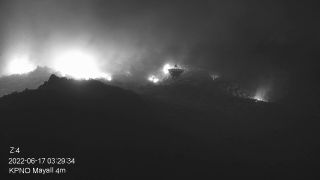Arizona wildfire reaches some of famed Kitt Peak's telescopes
Potential damage to the site cannot be assessed while the fire rages.

Update: Saturday evening (June 19), NOIRLab confirmed on Twitter that all the observatories at Kitt Peak remain standing. However, the site is still an active fire zone, "several non-science buildings" have been destroyed and even fully assessing the damage from the fire will take on the order of weeks.
Update on #Contrerasfire at @KittPeakNatObs: NOIRLab leadership viewed all scientific structures from a distance today. They report that all physical scientific observatory structures are still standing, but several non-science buildings were lost. https://t.co/k2rpp2Rc0R (1/7) pic.twitter.com/J5ondvfkPzJune 19, 2022
A large wildfire in Arizona is seriously threatening a key site for astronomy.
Kitt Peak National Observatory, in the southern part of the state, includes more than two dozen telescopes and has hosted astronomers for more than six decades. But now the site is facing the Contreras Fire, which began on June 11 and has been steadily growing due to high winds and lots of dry vegetation.
The fire reached the observatory early on Friday (June 17), according to a statement released later in the day by the National Science Foundation's National Optical-Infrared Astronomy Research Laboratory (NOIRLab), which operates the site.
Related: Satellites watch devastating fires blaze across northern New Mexico
NOIRLab says it can't assess damage to the facility while the blaze continues.
"Safety remains our top priority," officials wrote in the statement. "We are working with the firefighters at the site to assess the damage and will share details about the facilities as we learn more. We remain in an active fire situation with rapidly changing conditions."
Get the Space.com Newsletter
Breaking space news, the latest updates on rocket launches, skywatching events and more!
Last frame before the webcam cut out at the VLBA antenna on Kitt Peak. This is the next one north from the 12m I use, and of course near all the other KP telescopes that 100s of other scientists use. All of the webcams I know of on KP are now down. Waiting & hoping for good news. pic.twitter.com/p0Z8V4MinAJune 17, 2022
At about 2 a.m. local time (5 a.m. EDT and 0900 GMT) on Friday, the fire crested a ridge that holds four of the observatory's telescopes: the Hiltner 2.4-meter Telescope, McGraw-Hill 1.3-meter Telescope, Very Long Baseline Array Dish and UArizona 12-meter Telescope, according to the statement. These telescopes are located at a distance of about 3,000 feet (0.9 kilometers) from the rest of the observatory, according to Google Maps.
The Contreras Fire began on June 11 with a lightning strike in the Baboquivari Mountains south of the observatory. As of Friday morning, after less than a week, the blaze had covered nearly 11,500 acres (4,650 hectares), according to a website operated by a team of federal agencies. Nearly 300 people were working to stop the fire, which they hope to contain by June 26.



The observatory was evacuated on Wednesday (June 15) after preparing the telescopes to be left on their own as concerns about the fire increased. On Thursday (June 16), firefighters covered key parts of the blaze with fire retardants and cleared vegetation around key observatory buildings in an attempt to protect them. Personnel also shut off power to the observatory early on Friday.
Firefighters working to contain the Contreras Fire are facing temperatures over 100 degrees Fahrenheit (40 degrees Celsius), as well as high winds and very dry grass and brush. The weekend may bring scattered showers that could help slow the blaze.
Email Meghan Bartels at mbartels@space.com or follow her on Twitter @meghanbartels. Follow us on Twitter @Spacedotcom and on Facebook.
Join our Space Forums to keep talking space on the latest missions, night sky and more! And if you have a news tip, correction or comment, let us know at: community@space.com.

Meghan is a senior writer at Space.com and has more than five years' experience as a science journalist based in New York City. She joined Space.com in July 2018, with previous writing published in outlets including Newsweek and Audubon. Meghan earned an MA in science journalism from New York University and a BA in classics from Georgetown University, and in her free time she enjoys reading and visiting museums. Follow her on Twitter at @meghanbartels.